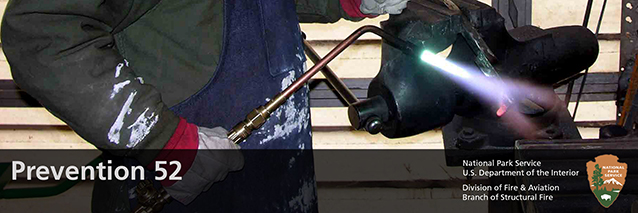
T. Scott Williams / NPS
Hot work is any type of work that can produce a source of ignition when combustible material is present. This includes welding, torch cutting, soldering, and work done with tar kettles. Building fires caused by this type of work are quite common. The National Park Service has documented a number of such fires. San Francisco Maritime National Historic Park suffered a major loss when contractors converting a historic building into a hotel, museum, and retail space ignited a fire during hot work in 2002. Though the building was saved, the roof and portions of one floor were heavily damaged. In another example, in the spring of 2012 a construction project involving hot work caused a fire in the historic Old Faithful Inn in Yellowstone National Park. Fortunately the fire was suppressed before major damage occurred.
How do we minimize the risk of a fire when hot work is being done?
National Park Service Reference Manual 58, Chapter 6, which addresses fire prevention, has a section on hot work and the required procedures to be followed. Many hot work projects can be completed in a designated hot work site, such as a welding shop. These areas are designed to be safe for these fire-prone activities and should be kept clean of debris and flammables. If a project must be done outside of a designated hot work site, a hot work permit must be issued. The permit will ensure that proper protective measures have been addressed, including:
- Fire extinguisher is present
- Combustible materials are removed or covered with appropriate fire-proof covers,
- A person serves as a fire watch when necessary, for instance, when the work is done within 35 feet of combustible materials.
Common hot work methods can be dangerous. Take time to ensure that safe practices are in place prior to beginning any hot work. This could mean the difference between an improvement project being finished on time OR an entire building being lost to fire.
Fire Info for You
Park Structural Fire Coordinators/Park Leadership
Does your park have hot work guidelines in place and follow proper policy for all such work? If not, this is a great project to bring to your park structural fire coordinator. Working together with the park safety officer will ensure that the park is not only following proper policy, but creating a safer work environment for everyone.
Take Action
If you are involved in work that incorporates hot work, ensure that all safety procedures are met and that a valid hot work permit has been issued for that day. If you are unsure of the required safety procedures, talk with your supervisor, safety officer, or park structural fire coordinator to obtain relevant safety training.
NPS Fire Facts
From the NPS Morning Report, 1990: Park painters were removing paint with a torch when a fire broke out in the attic of a historic park-owned house. The Philadelphia Fire Department responded and extinguished the fire. The building suffered from charring, smoke and water damage, and structural damage to attic beams. The park's chief ranger and his family, who lived in the house, were on vacation at the time of the fire.
Last updated: October 26, 2016
